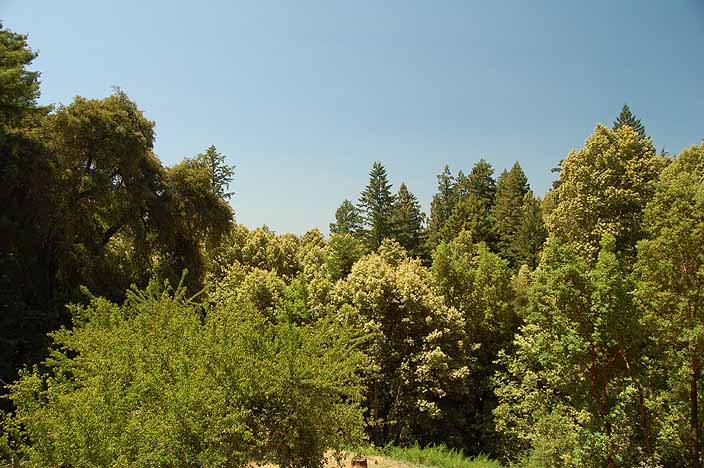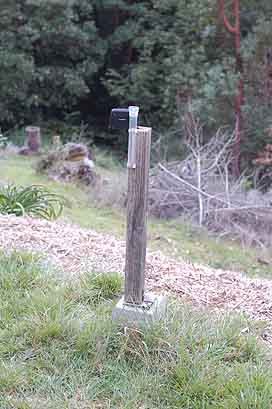Recent View looking South

06-13-07 at 11:45 AM
Clear and warm
Measured at 2,200 feet AMSL, near the junction of Empire Grade and Pine Flat

| July 2006 | . |
. . |
. . |
. |
. |
. |
. |
. | . | . | . | . |
Total: | ||||
|---|---|---|---|---|---|---|---|---|---|---|---|---|---|---|---|---|---|
| August 2006 | . |
. |
. |
. |
. |
. |
. |
. | . | . | . | . |
. |
Total: | |||
| September 2006 | . |
. |
. |
. |
. |
. |
. |
. . |
. |
. | . | . | Total: | ||||
| October 2006 | . |
4th .5" |
. |
. |
. |
. | . |
. . |
. |
. |
Total: .5" | ||||||
| November 2006 | 2nd: 2.0" |
. |
. |
11th: .55" |
13th: 3.05" |
22nd: .1" |
26th: 1.15" |
27th: .1" |
Total: 6.95" | ||||||||
| December 2006 | 8th: 1.6" |
9th: 2.15" |
10th: .9" |
12th: 1.65" |
13th: .35" |
15th: .25" |
16th: .2" |
21st: 1.5" |
. . |
. . |
27th: 2.2" |
30th: trace |
Total: 10.6" | ||||
| January 2007 | 4th: .55" |
. . |
17th: .15" |
. |
. |
. |
26th .25" |
27th: 1.0" |
28th: .15" |
29th: trace |
. |
. |
Total: 2.05" | ||||
| February 2007 | 7th: 1.4" |
8th: 1.25" |
9th: 3.9" |
10th: 4.25" |
11th: .65" |
12th: .75" |
21st: .15" |
22nd: 1.95" |
23rd: .4" (snow) |
24th: 1.2" |
25th: .4" |
26th: 1.4" |
27th: .35 (snow) |
28th: .5" (snow) |
Total: 18.55" | ||
| March 2007 | 1st: .1" |
. |
. |
20th: .15" |
. |
. |
26th: .5" |
. |
Total: .75" | ||||||||
| April 2007 | . |
11th: .35" |
. |
14th: .25" |
20th: .5" |
22nd: 2.2" |
. . |
. . |
. . |
. |
Total: 3.3" | ||||||
| May 2007 | . . |
2nd: .25" |
. . |
. |
. . |
. . |
. |
. . |
. . |
. . |
. |
. |
. |
. |
Total: .25" | ||
| June 2007 | . |
. . |
. |
. |
. . |
. . |
. |
. |
. |
. |
. |
. |
Total: | ||||
| Seasonal Total | 43.15 Inches | ||||||||||||||||
Just for comparison, you can look at a table of rainfall totals for a few previous seasons:
The first half of September was pleasant, and temperatures were moderate, and not too hot at all. October 1st brought much cooler temperatures, and the first drops of rain in nearly five months. The cool temperatures lingered, and the first real rain of the season arrived on October 4th. But indian summer followed, and the rest of October was mild and pleasant, and very dry. November finally brought some significant moisture on the second day of the month. Dry but cool conditions returned until the 11th, when the first of a series of fronts moved across central coast. The 13th brought a fairly wet storm across our ridgetop. A very brief shower moved across the ridge on the 22nd, and left much cooler temperatures behind. A brief but heavy band of showers passed over during the evening of the 26th. Early December brought warmer, sunny days, quickly followed by a wet and windy set of storms starting on the 8th. A cold snap arrived on the 16th, bringing temperatures in the upper 20's and low 30's, with hail and a little corn snow. A brief storm on the 21st moderated the temperatures but made it soggy again on the mountain. A strong storm with high winds roared through on the 27th, leaving a couple of inches of rain, followed by warm sunny days, including the first days of 2007.
A severe cold snap rolled in during the week of January 8th, and by the weekend of the 13th, night temperatures were in the low 20's and daytime temperatures only in the upper 20's and low 30's. The cold continued into the week of the 16th, with a trace of freezing rain overnight on the 17th. Temps warmed a bit over the next week, and some welcome rain arrived the night of the 26th. The remainder of January was mild and dry. February finally brought some needed moisture on the 7th, the first of a series of storms. The weather began to clear on the 11th, after leaving behind nearly 12 inches of rain. The warmth and sunshine returned briefly, and then a new batch of wet weather came down from Alaska on the 21st. A little snow fell overnight on the 23rd. The overcast and cold temperatures continued after that, along with damp conditions. Much colder air moved in during the storm that arrived on the 26th, leaving a light dusting of snow overnight and temperatures in the 20's. A fairly strong snowstorm arrived the afternoon of the 27th. And then the first of March arrived in lamb's clothing, warm and sunny. The dry sunny weather continued until the 20th, when a very brief shower rolled through. A return to pleasant weather was interupted by a downpour on the 26th, and much colder temperatures. Spring warmth returned on March 29th. April started out fairly pleasant, until a cold snap on the 10th, which brought a little rain on the 11th. By the 14th, a cold wind and light rain had made it feel more like late winter than early spring on the mountain. A very powerful (but brief) storm passed by and left over 2 inches of rain overnight on the 22nd. April then warmed and was sunny and nice during the remainder of the month.
May began with pleasant temperatures and then a brief shower on the 2nd brought a little well-needed moisture. After a few ups and downs in temperature, and no additional rain, mid-June finally appears to be bringing in the summer weather here. No more rain is on the horizon, and it will be a dry summer. This years rainfall amount is the lowest in at least 16 years.

I keep these unofficial readings as a personal interest. I have seen our reading exceed other gauges that are located at lower elevations nearby, so I figured this might be of interest to others. For rainfall amounts up to 5 inches, I use a retail rain gauge. When amounts overnight are higher than 5 inches, I use, as a backup, a simple vertical wall bucket capable of holding up to 14 inches. I have to use the bucket at least a few times every winter. In years past, I was distrustful about the unusually high rainfall readings, changing gauges and trying various methods and locations to improve accuracy. However, after much experimentation, and then checking with our neighbors, I think we are simply in a micro-climate with more rain than other places. This is the Santa Cruz Mountains, after all. As the Weather Service says, we are in an "Orographically Favored Location." I think that means we get soggy when others simply get wet.
During the 2005-2006 season, I added an electronic gauge. It sits next to the "analog" gauge. So far, it tracks very close to the old fashioned method of walking out in the rain and checking throughout the day and night. The electronic gauge reads hundredths better than the old gauge, so it is useful for that at least. I use both of them at the moment, and will likely use them both for the foreseeable future. You never know when the batteries might fail, after all.
There is one official California Department of Water Resources weather monitoring site located nearby, at a slightly higher elevation. They match my readings here at 2200' fairly well. You can compare for yourself, at Ben Lomond Mountain (2630', three miles up the road from here). Their measured rainfall tends to be slightly less, but the temperature tracks pretty close to our location.
There are also a couple of other nearby, lower elevation locations where rainfall is measured. One long-time measurement created by Ted Cantrall is here, and another very informative site, run by the folks at Anometal.com can be found here.
As with most places in this region, we are in a "micro-climate". Ours happens to be very wet during the rainy season, due to our location, elevation and southern exposure to incoming storms. During large storms, average winds of 40 to 60 mph are typical here. In December of 1995, we had winds approaching 100 mph, and during February, 1998, peak winds approached 85 mph. The season is officially measured from July 1 to June 30, although rain usually only falls between September and May, a typical "dry and wet" seasonal pattern. Snow does fall here, but it is usually not more than a few inches at a time. The temperature range is not too extreme, and only falls below 25 degrees a few weeks every winter. 1991 was the exception, with lows in the teens for over a week. The winters of 1973, 1975, 1982, 1986, 1995, 1998, 2001, 2002 and 2006 brought significant snowfall.
If you found your way to this page via a search engine, please refresh or reload the page for the latest updates.
You can return to the Home page here.